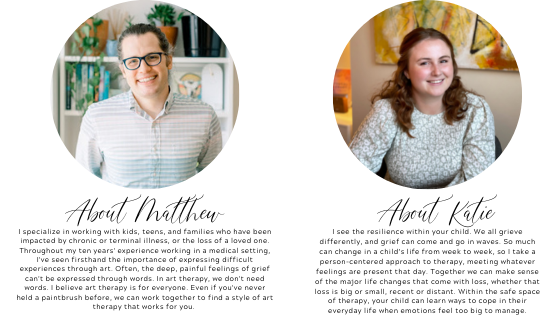Ask A Therapist: How Do I Help My Child with Their Grief?
When a child experiences a loss, especially the loss of a loved one, it’s tempting to get stuck in the realm of identifying injustice. How unfair, to experience tragedy so young. But how do we go from “unfair” to things that might actually help? It’s also challenging, if you’re also grieving, to then know how to help your child with their own grief, especially if it presents very differently from your own. I chatted with Associate Art Therapists Katie Gaynor and Matthew Brooks about their approaches to working with children who are grieving.
What are some common responses to grief that you see when working with kids?
KATIE: I have seen grief show up in some kids’ body language–moving around quickly, switching topics while talking. Kids' are often curious and ask questions about death–what happens after, will others die too. Reactions and responses can also vary depending on whether a child is in person or working with me virtually.
MATT: Depending on their age and development, children will have various responses to grief. But most children will display what we call "Big Feelings," typically followed by behaviors. Most parents report that these sudden outbursts of feelings and behaviors are exhausting, and that they feel lost when trying to help their child. Children may even display regressive behaviors, meaning that they will developmentally act younger than their age. When this happens, the child is emotionally going back to an age when they felt "safe." This may look like a child who is 7 or 8 years old suddenly having periods of yelling, destroying objects, hitting, or even biting. Parents will question why the child is behaving like this, when in reality they have stepped back into an emotional development stage of a 3 or 4 year old having a tantrum.
What’s your approach to talking to kids about hard topics like illness and death?
KATIE: When I work with children experiencing bereavement, I am often direct when talking about illness and death. Of course I want to create a safe, comfortable space for the kids I am working with, but we are also working together for a reason. While building the relationship with my clients, I often initiate conversations about loved ones who have died or are sick. Death can seem like a taboo topic, but loss is something that everyone will eventually have to encounter. I want the kids to know they have control over the conversation and that they can share as much or as little as they would like, and I always check in to make sure they are ready to talk about their person. When talking to kids about grief, I give them space for them to ask questions that may be difficult, especially if it’s something they aren't sure they can ask their parents. With younger children, I have also enjoyed using books as a doorway into talking about grief; then we create some art about the book we read together. Some of my favorites are “The Color Monster–A Story About Emotions” by Anna Llenas (not specifically about grief), “My Big, Dumb, Invisible Dragon” by Angie Lucas, and “The Invisible String” by Patrice Karst.
MATT: After forming a trusting relationship, I would say that my first step in working with children experiencing grief or illness is to understand what they understand. Where are they coming from? Most children may not fully understand what is going on or have the words to express what it is that they feel. I also want to emphasize that children are not oblivious to the loss or natural grief that they feel–it is there, and it is real. Most parents want to believe and even hope that their child does not have to experience the full weight of the grief that the adult is feeling, but the reality is that children are absorbing everything. Helping them process what they have gone through and will continue to feel is key to healing and navigating their resilience through the loss.
How does making art help kids with grief?
KATIE: Art making gives kids the opportunity to reflect inward and express themselves without words. Art making can also be an energetic process–it allows a release of energy through the art materials. Kids may respond differently to different materials, which is why working with an art therapist can be helpful–we are mindful of what materials to try, and can help express and contain if needed. I think making art also can be a way for kids to put how they are feeling into a place outside of themselves, hopefully allowing them to lighten the load they are carrying and leave it within the art.
MATT: Art can allow the space to process where words cannot. Children are building their language database, so they do not have all of the words or understanding to tell an adult what they are going through. Art can be a way for them to express those feelings, experiences, and thoughts.
We often think of grief as something we experience after a major loss, but adults might define “major” in a different way than children do. Are there things children grieve that we might not think to watch for?
KATIE: Moving is a big one, whether within the same neighborhood or further away. It is a big transition, and some kids may need extra support around that, especially with saying goodbye to the things they are used to and comfortable with. With this type of loss, there can also be a shift in perspective and seeing the good that has come out of the situation. Of course, this is not always the case. But moving and making new friends can be celebrated while we leave room for the grief of leaving behind what was comfortable and familiar.
MATT: Oh, for sure. Children are constantly going through new experiences. They might be grieving the loss of an object, identity, developmental stage, etc. This is why it’s so confusing for adults when, say, a toddler gets upset about something like “you turned off the bathwater.” Why are they upset about something so small? Trauma and loss are experiences that are crucial to every person’s development, but we’re talking about “small t” trauma. Fire is hot, how do we learn that? Building the skills within the child to help them navigate and persevere through difficult issues is essential to development.
Getting your child into therapy is a great way to help them with grief, but after two years of a global pandemic, services can be hard to come by. If you could give parents one piece of advice for their grieving child if therapy isn’t an option, what would it be?
KATIE: Be open and willing to engage in difficult conversations with your kids surrounding their grief, as well as your own, in an age-appropriate way. It can be hard to process your own grief while also trying to support your child, but I believe when kids can see that you may have similar feelings or questions, it gives them permission to reach out when they need support. Hiding your grief may lead your children to hide theirs, too, or feel that they need to move on when they are not yet ready.
MATT: My advice for parents is to sit down and have a conversation with your child. See where they are coming from and what they are understanding about what they are experiencing. Allow for the space to be judgment-free, and ask open-ended questions. It may be more insightful than you think.
Does your child need some extra support? Katie Gaynor has three after-school openings for new clients ages 6-18 who have been impacted by grief, loss, or trauma, or are experiencing anxiety or depression. Email info@alexandriaarttherapy.com to tell us more about your family and schedule a free consultation with Katie.
Don't miss an update--subscribe to our newsletter on Substack to receive new blog posts & the latest news in your inbox every other week.


